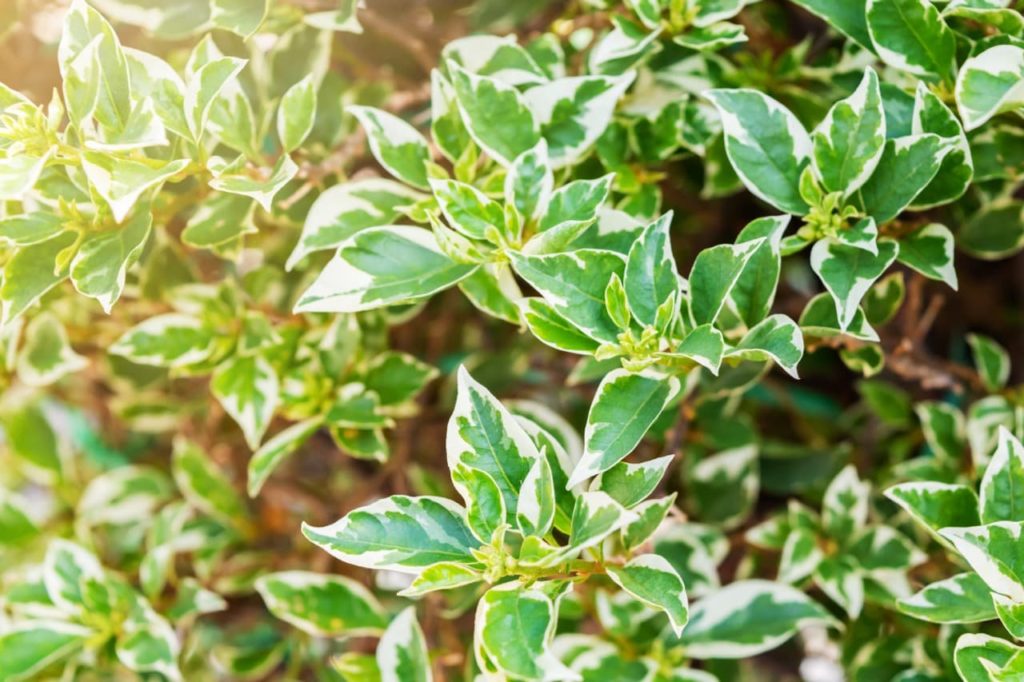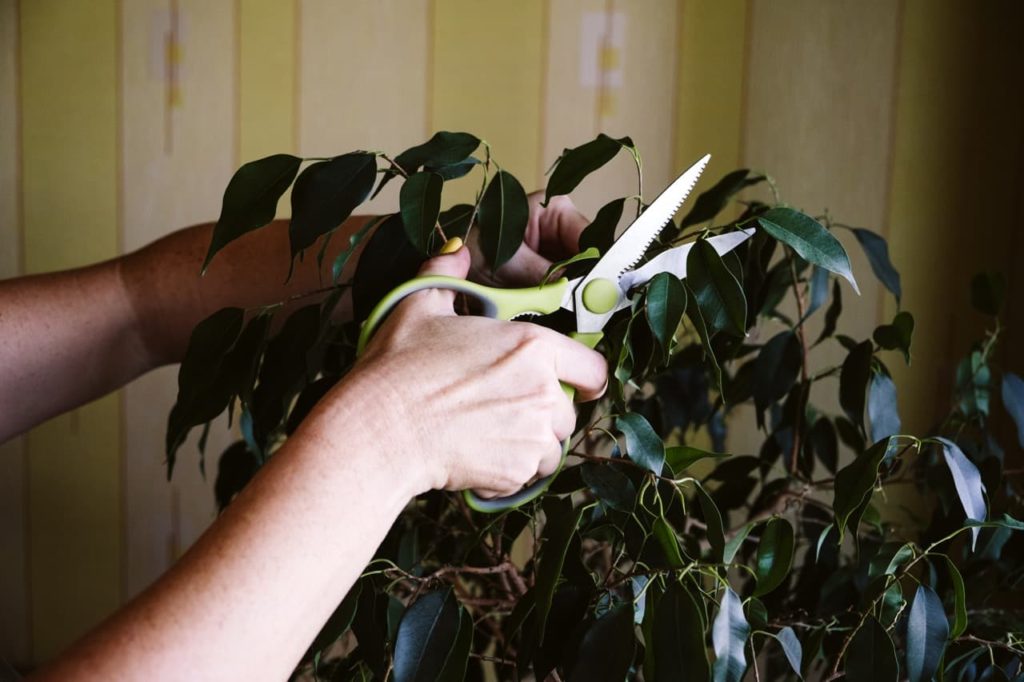HOUSEPLANTS > FICUS > BENJAMINA

Elizabeth is a Permaculture Garden Designer, Sustainability Consultant and Professional Writer, working as an advocate for positive change. She graduated from the University of St. Andrews with an MA in English and Philosophy and obtained a Diploma in Applied Permaculture Design from the Permaculture Association.
Reviewed By MOLLIE BROWN
IN THIS GUIDE
FICUS GUIDES
Ficus Benjamina
– Drooping Leaves
Fiddle Leaf Fig
Rubber Plant
Ficus benjamina, also known as the ‘Weeping Fig’, ‘Java Fig’ or ‘Java Tree’, is a popular houseplant.
It can be placed outside in summer in a mild and sheltered position, but it is commonly grown indoors year-round.
It is highly prized as a houseplant for its elegant form and glossy green leaves.
Overview
| Botanical Name | Ficus benjamina |
| Common Name(s) | Weeping Fig / Java Fig / Java Tree |
| Plant Type | Houseplant / Tree / Shrub |
| Native Area | Southeast Asia and Australia |
| Hardiness Rating | H1C |
| Foliage | Evergreen |
| Flowers | Inconspicuous, followed by reddish-orange fruits which turn black |
| When To Plant | May to September |
| When To Prune | January to March |
Sunlight
Preferred
Bright but indirect light
Exposure
Sheltered
Size
Height
2.5 – 4M
Spread
1.5 – 2.5M
Soil
Preferred
Loam-based compost
Moisture
Moist but well-drained
pH
Any
With the right care, this plant can look seriously impressive and bring a taste of the tropics to a home.
It also has a tolerance for relatively poor growing conditions, making it a good choice for those who are not necessarily the most green-fingered of people and for those looking for a relatively low-maintenance houseplant that won’t be too fussy to grow.

Common Types
As well as growing the species type Ficus benjamina, which has received an Award of Garden Merit from the RHS, you can also consider a variegated version with white variegation on the leaves.
The variegated cultivar ‘Starlight’ has also been given an Award of Garden Merit.

There are also compact cultivars to choose from if space is limited.
‘Too Little’, for example, is popular with bonsai enthusiasts.

Weeping Fig Care
Caring for a weeping fig is relatively simple as the plants are tolerant of a lot.
However, there are certain things that you do need to provide to grow these plants successfully, since not getting the basics right means that these plants can lose their leaves.
Below are the main things to think about.
Light & Temperature
Outdoors, where they can be placed in the summer, weeping figs require full sun to partial shade.
Indoors, where they are often kept, they will do well in a south or west-facing window, in bright but filtered light.

These plants can cope with temperatures of 5-10°C but not below and will not survive in freezing conditions.
A steady temperature of 16°C is ideal – which is why these plants are generally grown indoors or only placed outside in summer.
Preferred Soil
These plants need humus-rich soil which is moist yet free-draining.
A loam-based potting mix that is peat-free is generally considered to be the ideal growing medium when you are growing a Ficus benjamina indoors in a container.
Watering
Ficus benjamina will require regular watering, but it is also important not to overwater and to let the growing medium dry out somewhat between waterings.

Water deeply when the top few centimetres of the growing medium feel dry to the touch.
I would implore you to water well but to make sure that excess water can drain away freely.
I tend to find that if I am a neglectful plant parent and forget to water my Ficus regularly, this is a plant that is quite good at letting you know it is unhappy – often by wilting, turning yellow and dropping leaves.
Curtail watering, but do not stop entirely, during the winter months.
Feeding
During the spring and summer months, it is best to feed weeping figs with an organic, balanced liquid plant feed every couple of weeks.
I find that a seaweed feed is ideal, but feed only occasionally during the coldest part of the year.
Pruning
Ficus benjamina is in RHS Pruning Group 1 and has a naturally well-balanced framework of branches and a pleasing shape – so they don’t necessarily need pruning to keep them in shape.
Light maintenance pruning is all that will ever be required when growing these plants and even that light pruning is not always required.

In late winter or early in the spring, check the plants over and if there is any damaged, diseased or dead material, this can be pruned out.
You can trim branches that are crossing or overly congested too if you wish.
Repotting
It is not ideal to repot a Ficus benjamina too frequently.
These plants can have a tendency to drop their leaves in response to environmental change, which includes being moved to a new pot.
If they really need it, young weeping fig plants can be repotted into a slightly larger pot in the spring.
Once they are larger and more established, it is best to keep the same pot.
You can, however, replenish any nutrients by adding a top layer of compost in the existing pot each spring.
Overwintering
When a Ficus benjamina has been placed outside during the summer, it will need to be brought back indoors or undercover before temperatures drop below 13°C to avoid any issues.

Remember to reduce watering and feeding over the winter months and keep temperatures to 13°C or above at all times during the coldest part of the year.
Propagating
Ficus benjamina can be propagated by means of seed or cuttings.
Leaf buds or semi-hardwood cuttings can be taken to grow on and become new plants to add to your houseplant collection.
Common Problems
Like other houseplants, weeping figs can get infested with pests such as scale insects, mealybugs, thrips and red spider mites.
But most of the issues that occur when growing these plants arise because of a problem with the environmental conditions or because of a sudden change in the environment.
If you do notice your plant ‘acting up’, I’d generally advise you to look at light exposure and watering in the first instance.
FAQs
Can They Be Grown Outside?
Ficus benjamina can be placed outside during the summer months when temperatures are above 10-13°C, but it can be challenging to provide the right conditions outside in much of the UK.
Providing the 16°C needed year-round is instead much easier with indoor cultivation in our climate.
For this reason I would advise indoors-only growing in most parts of the UK.
How Are They Braided?
Young Ficus benjamina plants sometimes have their trunks and other main stems bent into a braid with one another for aesthetic appeal.

The idea is that this gives the trunk a more girthy and impressive appearance.
This does stress the plants at first but you can keep on top of this and raise one that will continue to grow over time.
Thin stems on a young plant are selected, and side branches are cut off.
The pliable stems are then braided, left one to middle, right one to middle and so on, and the stems are held in place with a small piece of tape or twine, loosely tied so as to not damage the plant.
How Can I Revive An Ailing Ficus Benjamina?
First, identify the cause of the problem, which will usually be environmental.
Look at temperatures, growing medium, water and feeding, consulting the above, to make sure that you have been getting things right when it comes to growing conditions and care.
Redress any problems and the plant may well recover. See our guide on drooping leaves for more recovery ideas.


